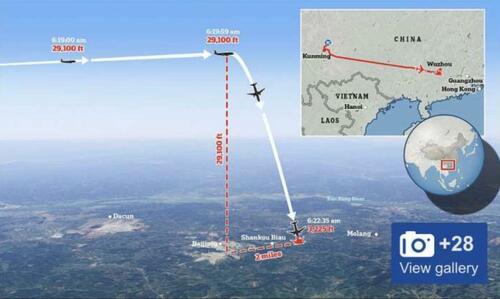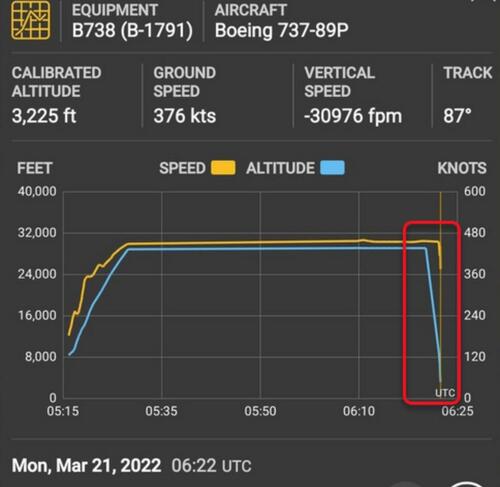Monday’s devastating crash of a Boeing 737 operated by China Eastern Airlines has gripped the US aviation industry (aka Boeing) in what’s shaping up to be another major scandal barely a year after the plane manufacturer had finally managed to move beyond the disastrous rollout of the 737 MAX 8, which left hundreds dead as a design flaw led to two crashes, one in Ethiopia and the other in Indonesia.
Those crashes prompted global groundings and an extensive investigation which revealed that the FAA had essentially abdicated its oversight responsibility – while one internal Boeing email blasted the MAX 8 for being designed by “clowns who were overseen by monkeys”.
As if the crash itself wasn’t embarrassing enough for the jet-maker, footage of the incident showing the plane essentially falling out of the sky has been seen by thousands, if not millions, of people, many of whom are already hoping for answers.
Chinese airlines haven’t bought any new Boeing planes for years at this point, and Monday’s crash raises the possibility that Boeing could be barred from the world’s second-largest market for air travel.
Local Chinese media reported shortly afterward that the crash had been caused by an electrical failure, but whether this is actually true remains unclear. At this point, little is known for certain about the circumstances surrounding the crash (and it will take investigators days, if not weeks, to examine the data from the plane’s “black box”, which must be recovered from the crash site in a mountainous region in Guangxi Province.
But as the investigation begins, the only thing we know for certain is that China’s first passenger airline crash in a decade is extremely unusual as far as plane crashes go. Why? Because, as the video below shows, the plane essentially dropped out of the sky, with the nose of the plane declining at an extreme angle.
According to experts quoted by Bloomberg, this gives the incident an extremely unusual profile.
While there have been a handful of crashes in which an airliner plunged from cruising altitude, few, if any, fit the extreme profile of the Boeing Co. 737-800 as it pointed steeply toward the ground, according to veteran crash investigators and previous accident reports.
“It’s an odd profile,” said John Cox, an aviation safety consultant and former 737 pilot. “It’s hard to get the airplane to do this.”
Just look at the angle of the plane seen in footage of the crash, which has been circulating on social media.
Dashcam footage of the China Eastern MU5735 crash. pic.twitter.com/H1MRgBWaAl
— Ian Miles Cheong (@stillgray) March 21, 2022
Aviation experts were shocked by the angle of the descent, which was essentially straight down…

…as the plane went from cruising altitude to dropping out of the sky in under two minutes, according to data from flight-tracking services.

The National Transportation Safety Board has already appointed a senior air safety investigator to investigate the incident (although given the pandemic-related travel restrictions still in place in China, it’s unclear how long it will take for US investigators to arrive on scene).
But as the investigation begins, aviation experts are already saying that the footage of the crash and the data cited above raises more questions, while offering few answers.
#Chinacrash — It’s often pretty clear in the hours after an airliner crash what the outlines of the failures were. I don’t feel that way at all in this case. #ChinaEastern https://t.co/u9nxqEUJ73
— Alan Levin (@AlanLevin1) March 21, 2022
And as the world waits to learn more, here’s what we know so far.
- Flight MU5735 was flying at an altitude of about 29,000 feet roughly 100 miles from its destination, about the point at which the pilots would begin the process of descending, when it started plunging at a far greater rate than normal. Instead of gradually dropping by a few thousand feet per minute, the plane began falling at more than 30,000 feet per minute within seconds, according to tracking data logged by Flightradar24.
- Flight-tracking data show that the plane dropped by 26,000 feet in the span of one minute, 35 seconds.
- In an unusual twist, the plane’s dive appeared halt for about 10 seconds, and it climbed briefly, adding an unusual twist to the scenario, before resuming the plunge. “It’s very odd,” said Jeff Guzzetti, the former accident investigation chief for U.S. Federal Aviation Administration.
- While there are some precedents in which passenger planes suddenly dropped from cruising altitude, most of these cases have important differences. For example, Air France Flight 447, which went down in the Atlantic Ocean on June 1, 2009, fell much slower and more erratically after speed sensors iced up and pilots became confused. All 228 people aboard that flight died.
- Another similar crash occurred on Dec. 19, 1997, when a pilot with Silk Air 737-300 carrying 104 people dove into a river in Indonesia, killing everyone on board. That plane plunged at more than 38,000 feet per minute, according to Indonesian regulators, who concluded that the pilot likely crashed the plane deliberately.
- Is that what happened in this case? Well, it’s unclear. The 737-800, like most other jetliners, is designed so that it won’t normally dive at steep angles. Forcing the plane to do so would likely require an extreme effort by a pilot, or a highly unusual malfunction.
- It’s possible the pilot could have suffered a heart attack or some other medical emergency and slumped onto thte control column, lowering the nose.
Earlier this evening, Boeing CEO David Calhoun sent a message to all employees:
We are deeply saddened by the news of the accident involving a China Eastern Airlines 737-800 airplane. The thoughts of all of us at Boeing are with the passengers and crew members on Flight MU 5735, as well as their families and loved ones.
We have been in close communication with our customer and regulatory authorities since the accident, and have offered the full support of our technical experts to the investigation led by the Civil Aviation Administration of China.
I will keep you apprised of information about the accident as investigation protocols allow. In the meantime, trust that we will be doing everything we can to support our customer and the accident investigation during this difficult time, guided by our commitment to safety, transparency, and integrity at every step.
Dave
Answers will likely be forthcoming, although we suspect, given the crash occurred in China, may not be timely. But one thing is clear: something must have gone seriously wrong for the nose of the plane to have declined at such an extreme angle.
“You need something to hold the nose down,” said Benjamin Berman, a a former NTSB investigator who has experience flying 737s.
Republished from ZeroHedge.com with permission










Sign up on lukeunfiltered.com or to check out our store on thebestpoliticalshirts.com.